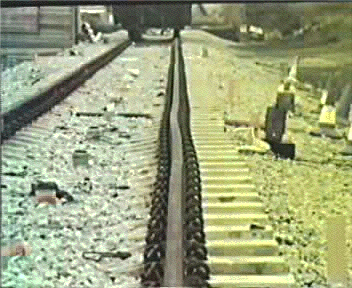How hot weather affects the railway
22 April 2024 by James
For many of us, the sun is a welcome sight. However when temperatures start to climb, so does the number of problems on the railway - but why is that? Let's find out!

Buckling Rails
Tracks are made of steel, an alloy composed of iron and carbon. It's all around us: in buildings, bridges, tools and furniture just to name a few. However, like most metals, it expands when it gets hot - up to 20°C hotter than the air temperature. On a typical British day, that's not a problem. But in the summer when temperatures start to climb, the issue of heat becomes much more serious.
Tracks exposed to the sun could reach 60°C or even higher in particularly hot conditions. This heat can cause the track to expand and buckle. Even if the rails don't reach buckling point, they still need babying. Trains often have to slow down to reduce the stress, leading to delays. To understand why this happens, we need to picture how tracks work:
Rails aren't just sitting loose on the ground. They're attached to sleepers which hold them at a fixed distance – the track gauge. When the rails get hot and want to expand, they're fighting against this fixed spacing. That's when buckling can occur, like a spring under pressure that suddenly pops out of shape.

Advertisement
Sagging Overhead Lines
It's not just the rails that suffer in the heat - the overhead power lines do too. Just like the steel tracks, they can expand in the heat, resulting in them hanging lower than nomal. This puts the trains at risk: the pantographs could catch on a drooping wire, ripping everything down.
In some cases, this can even lead to the train derailing, which is why speed restrictions are often put in place. I don't know about you, but I'd rather my train remains upright, even if it means the journey takes a little longer!
Conclusion
While heat will always present challenges across the railway, new technologies and plans are always being developed to help mitigate the risks and ensure chaos is kept to a minimum during the summer.
If you want to read more about how hot weather affects the railway across the UK, check out this brilliant article by Network Rail.
Thank you to Luis Graterol/Unsplash for the picture of the sun, and pwayblog.com for the animation.
Comments
Please sign in or create an account to comment.
Latest articles
-
1⚠️ Global IT outage - Check before you travel ⚠️
-
2Introducing the Knowledge Hub
-
3Avanti's brand new Class 805s are here: any good or another hopeless Hitachi?
-
4Exclusive behind the scenes with an inspirational LNER train driver
-
5End of the road for London's Boris Buses as mayor reveals zero-emission plan
Advertisement
Advertisement